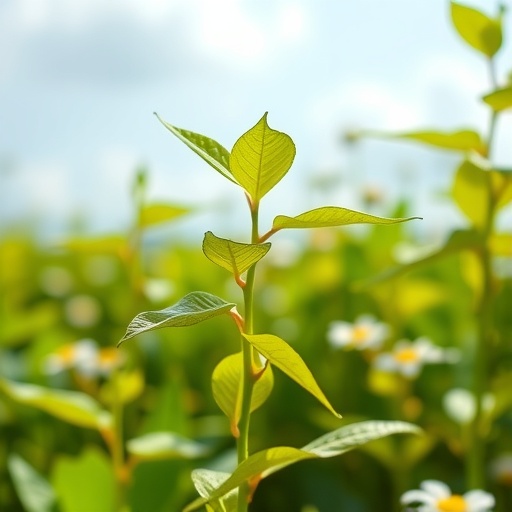Australian scientists have achieved a remarkable breakthrough by engineering nanoscale compartments designed to supercharge photosynthesis, a development that could revolutionize food production by increasing crop yields while dramatically reducing water and nitrogen fertilizer use. This innovative approach centers on enhancing the efficiency of Rubisco, the critical enzyme responsible for carbon fixation in plants, which has long been recognized as a bottleneck in photosynthetic productivity.
Rubisco plays a pivotal role in the photosynthetic process, catalyzing the assimilation of carbon dioxide (CO₂) into organic molecules that fuel plant growth. However, this enzyme is notoriously sluggish and prone to a costly error: it frequently reacts with oxygen instead of CO₂, triggering a wasteful process that saps the plant of vital energy and resources. Such inefficiency forces crops like wheat, rice, canola, and potatoes to compensate by producing enormous amounts of Rubisco protein, sometimes making up half of the total soluble protein in their leaves—an immense metabolic burden that limits growth under resource constraints.
To address this fundamental challenge, researchers led by Associate Professor Yu Heng Lau at the University of Sydney and Professor Spencer Whitney at the Australian National University have pioneered an elegant solution inspired by nature’s own adaptations found in algae and cyanobacteria. These organisms encapsulate Rubisco within specialized microcompartments called carboxysomes, which concentrate CO₂ around the enzyme, vastly enhancing its catalytic speed and accuracy. Unfortunately, transferring these complex, multi-gene organelles into crops has proved difficult due to their structural intricacy and the requirement for a tightly balanced genetic and biochemical environment.
Departing from the conventional path, the Australian team adopted encapsulins—simple bacterial protein cages that self-assemble from a single gene product—as modular “nanocompartments” capable of housing Rubisco enzymes. Think of encapsulins as molecular Legos that snap together automatically, providing a customizable scaffold that can be programmed to encapsulate various types of Rubisco. By appending a short “address tag” peptide sequence to the Rubisco enzyme, they effectively devised a postal code system that guides the enzyme into the encapsulin during its assembly, enabling precise packaging.
Their experimental work demonstrated that the timing of assembly is crucial: for complex Rubisco forms, it was necessary to first synthesize fully assembled Rubisco enzymes, then encapsulate them within the protein shell, as simultaneous assembly led to improper folding or aggregation. Intriguingly, the system’s modularity allows for encapsulation of Rubisco variants from plants as well as bacteria, marking a significant departure from natural carboxysomes which only accommodate their native Rubisco proteins.
One particularly exciting finding was that the pores of the encapsulin shell permit the exchange of substrates and products—namely CO₂ and the organic molecules resulting from carbon fixation—thus maintaining active enzymatic function while benefiting from the concentrated local environment. This suggests that these engineered nanocompartments could recreate the CO₂-enhanced milieu that nature optimized in microalgae, but with a system that is far simpler to manipulate genetically and biochemically.
While this research currently represents a proof-of-concept, the implications for agriculture are profound. Early-stage experiments have already begun introducing encapsulin systems into plants, aiming to produce crops that can photosynthesize more efficiently, grow faster, and require fewer inputs such as water and nitrogen fertilizers. These advantages are increasingly urgent in the face of climate change and a growing global population demanding sustainable food production.
The researchers emphasize that further work is required to incorporate additional components essential for replicating the full high-performance environment observed in cyanobacterial carboxysomes. However, their approach breaks new ground by offering a synthetic biology toolset to engineer carbon-fixing organelles that are modular, adaptable, and genetically simpler than existing biological analogs.
This breakthrough was made possible through a multidisciplinary collaboration, integrating principles of synthetic biology, molecular biology, and biochemistry. Lead author Dr. Taylor Szyszka from the ARC Centre of Excellence in Synthetic Biology at the University of Sydney highlighted that this system’s flexibility could usher in a new era of tailored carbon fixation technologies in crop plants, tailored to specific types of Rubisco enzymes and potentially unlocking yield improvements across diverse agricultural settings.
The significance of this work lies not only in its potential to enhance photosynthetic efficiency but also in its contribution towards sustainable agriculture. By enabling plants to fix more carbon with less water and fertilizer, this technology could alleviate critical environmental pressures, lower the carbon footprint of farming, and help secure food supplies under increasingly volatile climate conditions.
Published in Nature Communications in late 2025, this study exemplifies the transformative power of synthetic biology in solving longstanding biological challenges. The encapsulin nanocompartment system extends the frontier of bioengineering, providing researchers with a versatile platform to reprogram intracellular environments and improve plant metabolic efficiency in ways previously thought unattainable.
As the scientific community eagerly anticipates further developments, the successful demonstration of programmable nanocompartments offers a glimpse into a future where crop yields are boosted not by external inputs alone but by engineering the internal molecular machinery of photosynthesis. The road ahead will focus on refining these encapsulin-based compartments, integrating them effectively into plant physiology, and field testing their performance under real-world agricultural conditions.
In essence, this breakthrough could mark a paradigm shift in how we approach crop improvement—transforming plants into highly efficient carbon fixers capable of thriving in resource-limited environments, which is imperative for feeding the world sustainably in the decades to come.
Subject of Research: Cells
Article Title: Reprogramming encapsulins into modular carbon-fixing nanocompartments
News Publication Date: 30-Oct-2025
Web References:
https://www.nature.com/ncomms/
http://dx.doi.org/10.1038/s41467-025-65307-9
References:
Szyszka, T. and Wijaya, D. et al ‘Reprogramming encapsulins into modular carbon-fixing nanocompartments’ (Nature Communications 2025). DOI: 10.1038/s41467-025-65307-9.
Image Credits: Stefanie Zingsheim/University of Sydney
Keywords: Rubisco, photosynthesis, carbon fixation, synthetic biology, encapsulin, nanocompartments, crop yield, carbon-concentrating mechanisms, protein engineering, agriculture, sustainable food production




